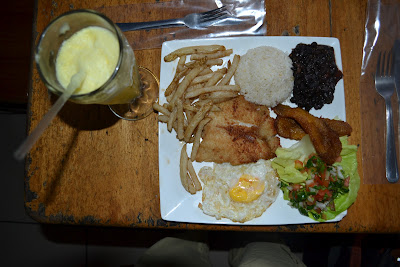The very next day the festival continued with a cultural parade of indigenous dancers and people supporting the local community. What I thought was interesting about both the festival and the parade was that it was put on through the church. The church sits directly in front of the plaza, where you can go to sit and enjoy an ice cream and the afternoon. Another component of the plaza are the shoppes that are centered around it. This makes for a very tight nit community that work together, practice religion together, and party together.
7/16/2012 Dr. Vargas hosts a language and food party. In attendance were some of the CATIE staff, some students from the MIST (Masters of International Sustainable Tourism) program, and ourselves. The goal of the party was to get the staff to learn English and the rest of us to learn Spanish all while having fun and cooking. Half of us cooked Chifrijo, which to me seems like a loaded nacho consisting of rice, beans, chunks of beef, topped with guacamole and pico de gallo and tortilla chips. The other half cooked a relatively Northern American dish, apple fritter. All of the food came out fantastic and practicing the language was a complete success.
7/20/2012 Dr. Bloomquist arrives and we head to Manuel Antonio. On our way there, there is an infamous bridge overlooking a river that is a huge tourist attraction. The reason that this bridge in particular is so well known is because this is where great numbers of crocodiles live. According to Eric, our instructor, this is where fresh water meets salt water and is a perfect environment for the crocs to live in. If it gets too hot during the day, they wade underneath the overpass until it cools down.
Manuel Antonio is the beach of all touristic beaches. There are people from all around the world lodging in or near Manuel Antonio to catch some waves, shop at the souvenir shops or enjoy the night life. I was shocked at the completely different vibe that little old Turrialba has in comparison to the bustling Manuel Antonio. We did three things while in Manuel Antonio – went to the national park, took a tour of a 5 leaf/ 5 star hotel and caught some waves. The national park, although a fantastic park, was situated near the touristic area of Manuel Antonio. This was problematic because there were too many people in the park which destroyed the naturalistic feel that the park is supposed to give. Mostly what we spotted were white faced monkeys but was fortunate to see two sloths who are known to be found in this region. Sadly, visitors to the park often feed the monkeys snacks and junk foods and these monkeys will get sick and die from having such a poor diet. There are signs everywhere warning visitors against feeding the monkeys, however, on the park beaches the opposite occurred.
Next was the hotel tour. Before I begin to explain the tour I have to shed some light on this leaf system that has been adopted by Costa Rica. The leaf system is a sustainable approach to the star system. How it works is that a hotel will gain points based off of how they maintain and sustain their resources. They can get points for having solar panels, having recycle bins, hiring locals, etc., and these points will determine how sustainable the hotel is. The more sustainable a hotel is, the more leafs it will earn. We went on the tour to see just how a five leaf hotel operated and the processes that needed to be done in order to keep their leaf rating.
Fun came next. After all of our hard work and learning, we finally got to take a break and try out surfing. This was all of our first time and there is no better place to try it out than at the Rich Coast. Board rentals - $20. Bathing suit - $40. Being thrashed around on a wave with a board tied to your ankle - priceless. In all honesty, that was well worth the scars and bruises that I found the next day.












